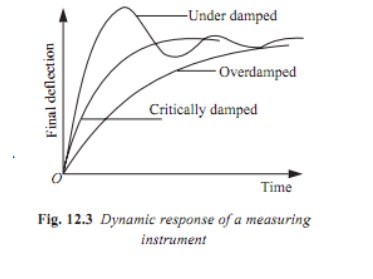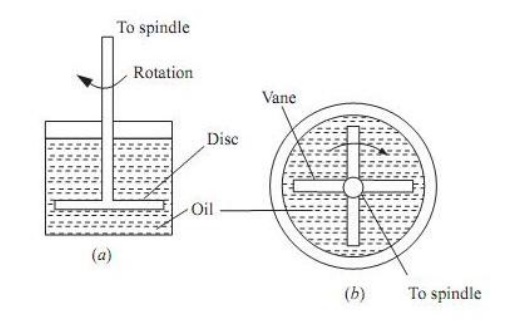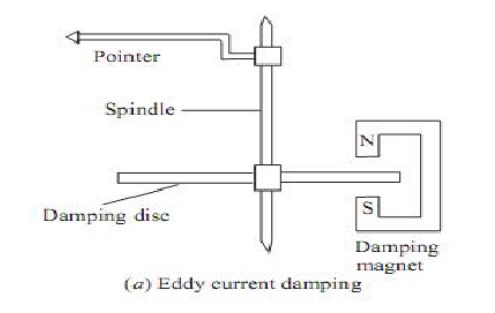Chapter: Basic Electrical and electronics : Electric Circuits and Measurements
Damping Torque and Classification of Damping Damping Torque
Damping Torque

We have already seen that the moving system of the instrument will tend to move under the action of the deflecting torque. But on account of the control torque, it will try to occupy a position of rest when the two torques are equal and opposite. However, due to inertia of the moving system, the pointer will not come to rest immediately but oscillate about its final deflected position as shown in Fig and takes appreciable time to come to steady state. To overcome this difficulty a damping torque is to be developed by using a damping device attached to the moving system.
The damping torque is proportional to the speed of rotation of the moving system, that is Tv = kv d dt θ
where kv = damping torque constant
d dt θ = speed of rotation of the moving system
Depending upon the degree of damping introduced in the moving system, the instrument may have any one of the following conditions as depicted in Fig.
1. Under damped condition: The response is oscillatory
2. Over damped condition: The response is sluggish and it rises very slowly from its zero position to final position.
3. Critically damped condition: When the response settles quickly without any oscillation, the system is said to be critically damped.
In practice, the best response is slightly obtained when the damping is below the critical value i.e., the instrument is slightly under damped.
The damping torque is produced by the following methods: Air Friction Damping & Fluid friction damping
Air Friction Damping
In this type of damping a light vane or vanes having considerable area is attached to the moving system to develop a frictional force opposing the motion by reason of the air they displace. Two methods of damping by air friction are depicted in Fig.
The arrangement shown in Fig consists of a light aluminum vane which moves in a quadrant (sector) shaped air chamber. The chamber also carries a cover plate at the top. The vane is mounted on the spindle of the moving system. The aluminum vane should not touch the air-chamber walls otherwise a serious error in the deflection of the instrument will be introduced. Now, with the motion, the vane displaces air and thereby a damping force is created on the vane that produces a torque (damping) on the spindle. When the movement is quicker the damping force is greater; when the spindle is at rest, the damping force is zero.
The arrangement of Fig. consists of a light aluminum piston which is attached to the moving system. This piston moves in a fixed chamber which is closed at one end. Either circular or rectangular chamber may be used. The clearance (or gap) between the piston and chamber walls should be uniform throughout and as small as possible. When the piston moves rapidly into the chamber the air in the closed space is compressed and the pressure of air thus developed opposes the motion of the piston and thereby the whole moving system. If the piston is moving out of the chamber, rapidly, the pressure in the closed space falls and the pressure on the open side of the piston is greater than that on the opposite side. Motion is thus again opposed. With this damping system care must be taken to ensure that the arm carrying the piston should not touch the sides of the chamber during its movement. The friction which otherwise would occur may introduce a serious error in the deflection.
The air friction damping is very simple and cheap. But care must be taken to ensure that the piston is not bent or twisted. This method is used in moving iron and hot wire instruments.
Fluid Friction Damping

This form is damping is similar to air friction damping. The action is the same as in the air friction damping. Mineral oil is used in place of air and as the viscosity of oil is greater, the damping force is also much greater. The vane attached to the spindle is arranged to move in the damping oil. It is rarely used in commercial type instruments. The oil used must fulfill the following requirements. It should not evaporate quickly . It should not have any corrosive effect on metals. Its viscosity should not change appreciably with temperature. It should be good insulator.
Advantages of Fluid Friction Damping
1. The oil used for damping can also be used for insulation purpose in some forms of instruments which are submerged in oil.
2. The clearance between the vanes and oil chamber is not as critical as with the air friction clamping system.
3. This method is suitable for use with instruments such as electrostatic type where the movement is suspended rather than pivoted.
4. Due to the up thrust of oil, the loads on bearings or suspension system is reduced thereby the reducing the frictional errors.
Disadvantages of Fluid Friction Damping
1. The instruments with this type of damping must be kept always in a vertical position.
2. It is difficult to keep the instrument clean due to leakage of oil.
It is not suitable for portable instruments. The fluid friction damping can be used for laboratory type electrostatic instruments.
Eddy current damping
Eddy Current Damping

Eddy current damping is the most efficient form of damping. The essential components in this type of damping are a permanent magnet; and a light conducting disc usually of alumninum. When a sheet of conducting material moves in a magnetic field so as to cut through lines of force, eddy currents are set up in it and a force exists between these currents and the magnetic field, which is always in the direction opposing the motion. \
This force is proportional to the magnitude of the current, and to the strength of field. The former is proportional to the velocity of movement of the conductor, and thus, if the magnetic field is constant, the damping force is proportional to the velocity of the moving system and is zero when there is no movement of the system.
Related Topics